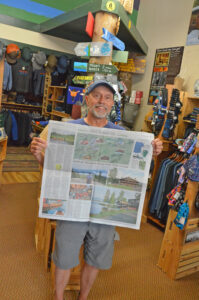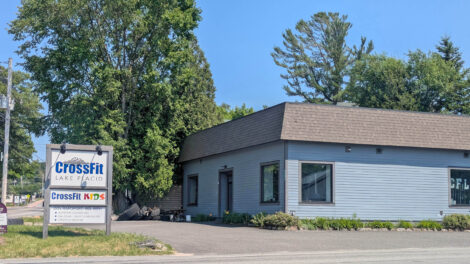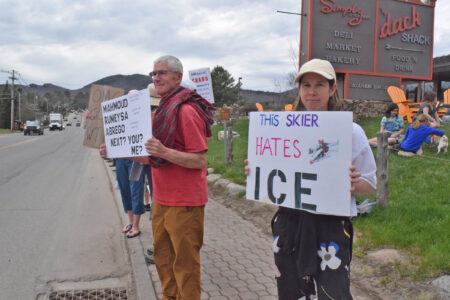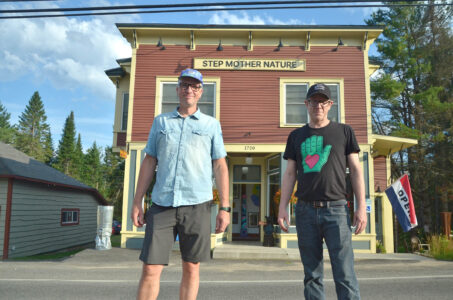Planning on hiking in the Adirondacks this fall? Expect a crowd

A sign on state Route 73 between Lake Placid and Keene flashes two messages to drivers: “HIKER PARKING LIMITED,” “SEEK OTHER HIKES.” The Cascade Mountain trailhead, about a quarter-mile down the road, is often overflowing with cars and the mountain might see 400 to 500 hikers on a weekend day. (Provided photo — USA Today Network)
LAKE PLACID — Most days this summer, long before the sun peeks out over the tops of the Adirondack Mountains, the parking lot at the Adirondak Loj trailhead is full.
The spots in the gravel lot, some 200 of them, quickly fill with cars. Out spill ambitious hikers, many experienced and dressed in layers, with hiking boots and rain jackets and light backpacks filled with food and water.
But lately, there’s another kind of hiker. The kind of person who gets out of the car wearing Crocs or flip flops, and plans on using their cell phone to navigate the trails during their hike.
Overcrowding along trails in the vast Adirondacks has been a growing problem for years, and it’s been exacerbated this year by the COVID-19 pandemic as travelers stay within driving distance of their homes and seek safe, outdoor activities.
Monitoring and supporting new visitors has long been a mission for various Adirondack organizations. And this year, education has become more important than ever.
Stu Weinberg, a retiree who volunteers with the Adirondack Mountain Club, sometimes is tasked with “hosting” — greeting people as they arrive, asking where they’re headed and assessing their level of preparedness.
He’s not there to reprimand them, he said. It’s more so about educating people, and giving them a bit of a reality check before they head off.
“Many people see a nice picture on Instagram and go, ‘Oh, we should do that,’ and really don’t do the research or have an understanding of what’s involved,” Weinberg said. “(We’re) seeing the lack of experience — or, how many new people there are.”
Last summer was hectic like this, too, Weinberg said. But with COVID-19 thrown into the mix and outdoor spaces deemed safe spaces, the Adirondack Park has seen a huge increase in visitors in the last few months.
It’s normal for the parking lot at the Loj (pronounced “lodge”) to fill up early on the weekends. But this year, Weinberg said, it’s been a daily occurrence — even without the additional Canadian hikers they’d normally have this time of year.
“In the media, being outdoors is one of those things that’s ‘good’ to do during the pandemic,” he said. “A lot of people who have never been in the outdoors before are now doing it.”
And that’s not necessarily a bad thing, he said. More use and more positive experiences helps the park in the long run, especially when it comes to preservation and donations.
The problem, locals say, is that leaf peeping season has just begun. It’s the time of year when the fall colors emerge, painting an already beautiful landscape in hues of orange and red and yellow.
And it also means plenty of people to dot the mountain views.
Tourism in the Adirondack Park generates more than $1 billion in economic impact annually, and an estimated 12.4 million people visit each year.
The Adirondack Park encompasses some six million acres in the North Country. A big draw are the High Peaks — 46 of New York’s tallest mountains, mostly in and around Essex County. Those who hike all of them call themselves 46ers.
The hikes are challenging, but the views are stellar.
In the last few years, spectacular photos from the summits of peaks like Algonquin, Marcy and Cascade have started to flood social media sites. Searching through posts with these locations tagged produces an endless stream of pictures of hikers with wide smiles posing in front of 360-degree mountain views.
Trying to identify the single reason why there’s been such an uptick in visitors to the High Peaks region in the last few years is simple, said Jim McKenna, CEO of the Regional Office of Sustainable Tourism in Lake Placid.
It all comes down to social media.
“The fact that the High Peaks is clearly the icon of Adirondack hiking — everybody wants to do it,” McKenna said. “We’re not really focusing on marketing the High Peaks — they market themselves, so to speak. And social media has certainly made that much more of an issue than it has historically.”
Coupling FOMO (a social media term short for “Fear Of Missing Out”) with health officials and government leaders encouraging people to exercise outdoors during the pandemic set the picturesque Adirondacks up for a busy summer — and soon fall.
Parking lots adjacent to hiking trail heads are often overflowing, with cars spilling out far beyond the allotted spaces and down the road. Trails themselves are crowded and busy. Hikers have to step off to the side to let others pass by, and masks are hit or miss.
Portable LED signs down the road from the Cascade Mountain trail on State Route 73, for example, even urge cars passing by to find another activity.
“HIKER PARKING LIMITED,” the sign flashes in bright orange lights. “SEEK OTHER HIKES.”
It’s difficult (and likely impossible) to pinpoint the exact number of visitors to the Adirondack Park in a given season, though McKenna said examining occupancy tax collections can help create a clearer picture.
This year, he said, those taxes dipped in March, April and May about 78% below what they were in 2019. In June and July, the difference has only been about 10%. He expects the data from this August to be comparable to last year, but hasn’t gotten those numbers yet.
In January, Gov. Andrew Cuomo said the state would develop “a framework to balance public use needs, working in collaboration with the State’s newly formed Adirondack High Peaks Strategic Planning Advisory Group.”
The move was applauded by Park advocates who have long clamored for more state attention to the overcrowding problem. The state has bolstered parking enforcement and sought to cut down on hikers stomping outside designated trails.
“The surge in demand for Adirondack Park open space highlights the need for the state to continue and intensify the progress it has made in curbing overcrowding and overuse on the park’s most popular trails, campsites and destinations,” Adirondack Council Executive Director William Janeway said in a statement.
The attraction to the Adirondacks this year is fueled by more Americans visiting, he said, as the border restrictions due to the pandemic have barred Canadians from entering the country.
Also, more homes are being bought to escape high-congestion areas, and those who already owned second homes upstate retreated to those more remote abodes and have stayed in the area through the pandemic, Janeway said.
“Better education, parking enforcement, investments in infrastructure, additional personnel and limits on use such as parking reservations all need to be part of the solution to this escalating problem,” he said.
The challenge Adirondack leaders have ahead is twofold, McKenna said: How do you make sure you help new and returning visitors experience all the Adirondacks have to offer, while also preserving and protecting all the wild and natural things that make the Park so great?
“It’s a difficult one to get the right balance, but I think we’re headed in that direction,” he said.




